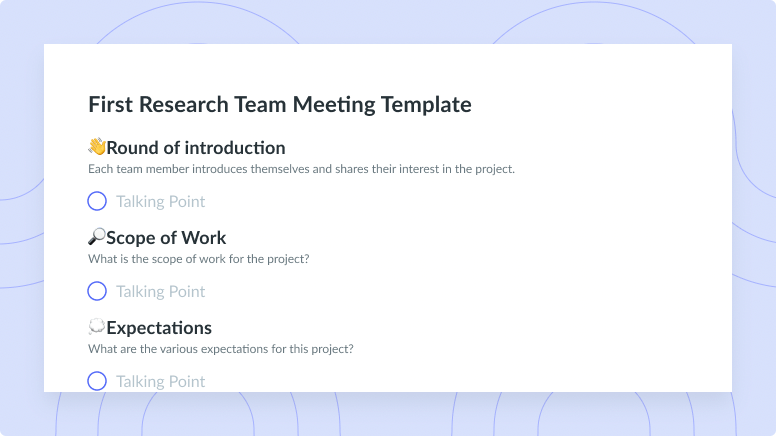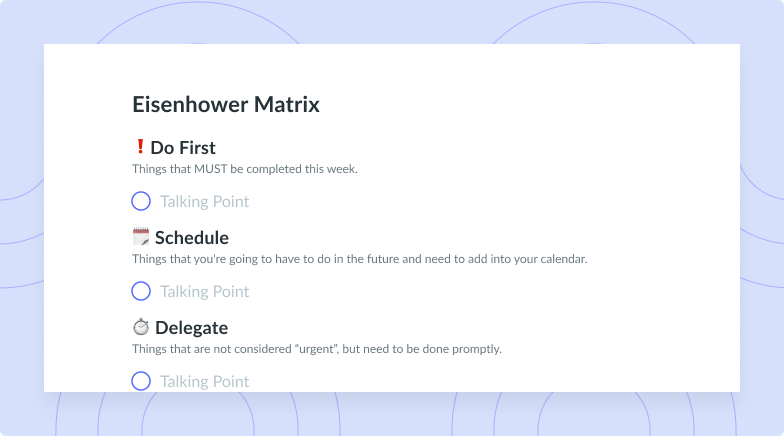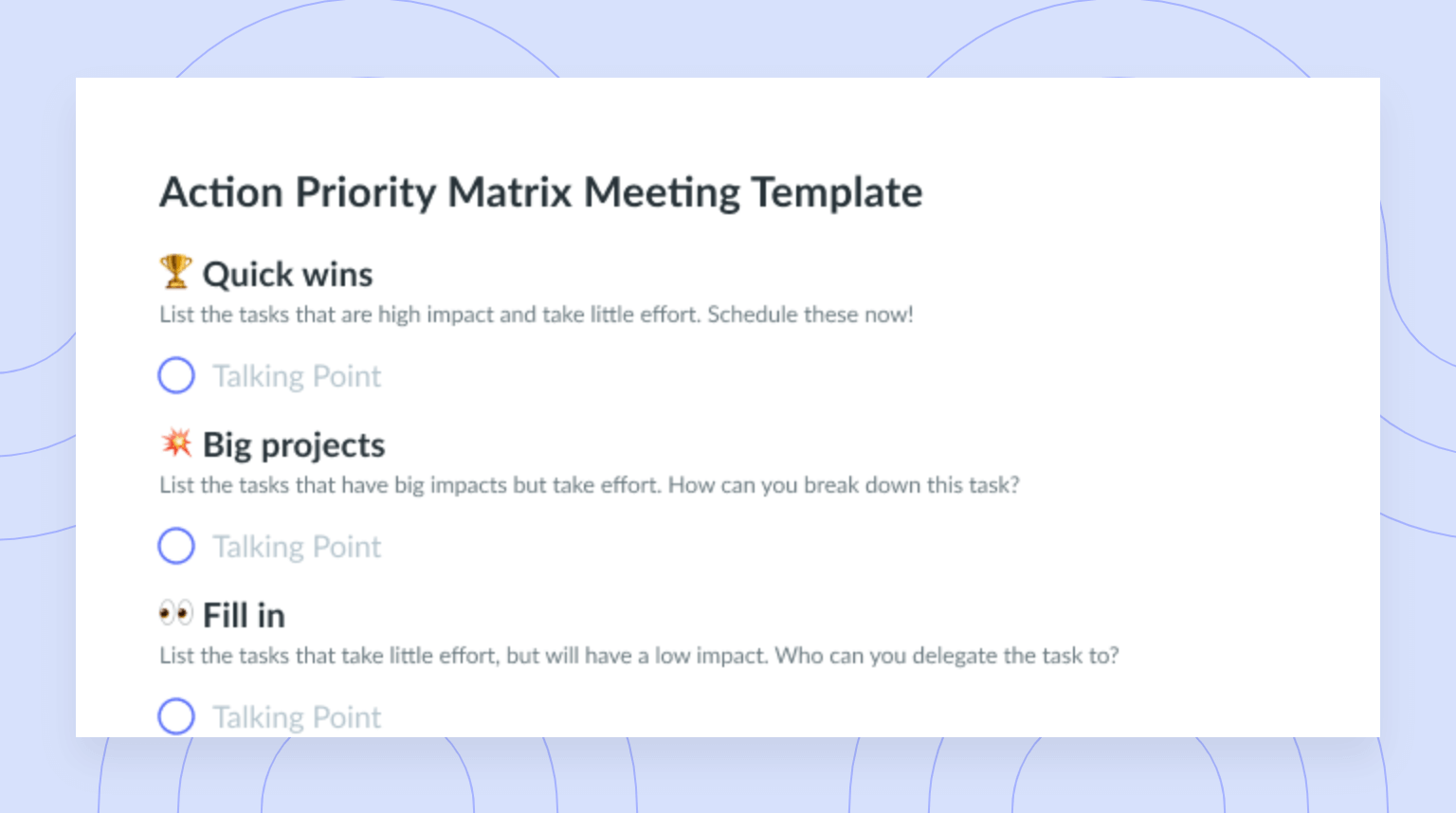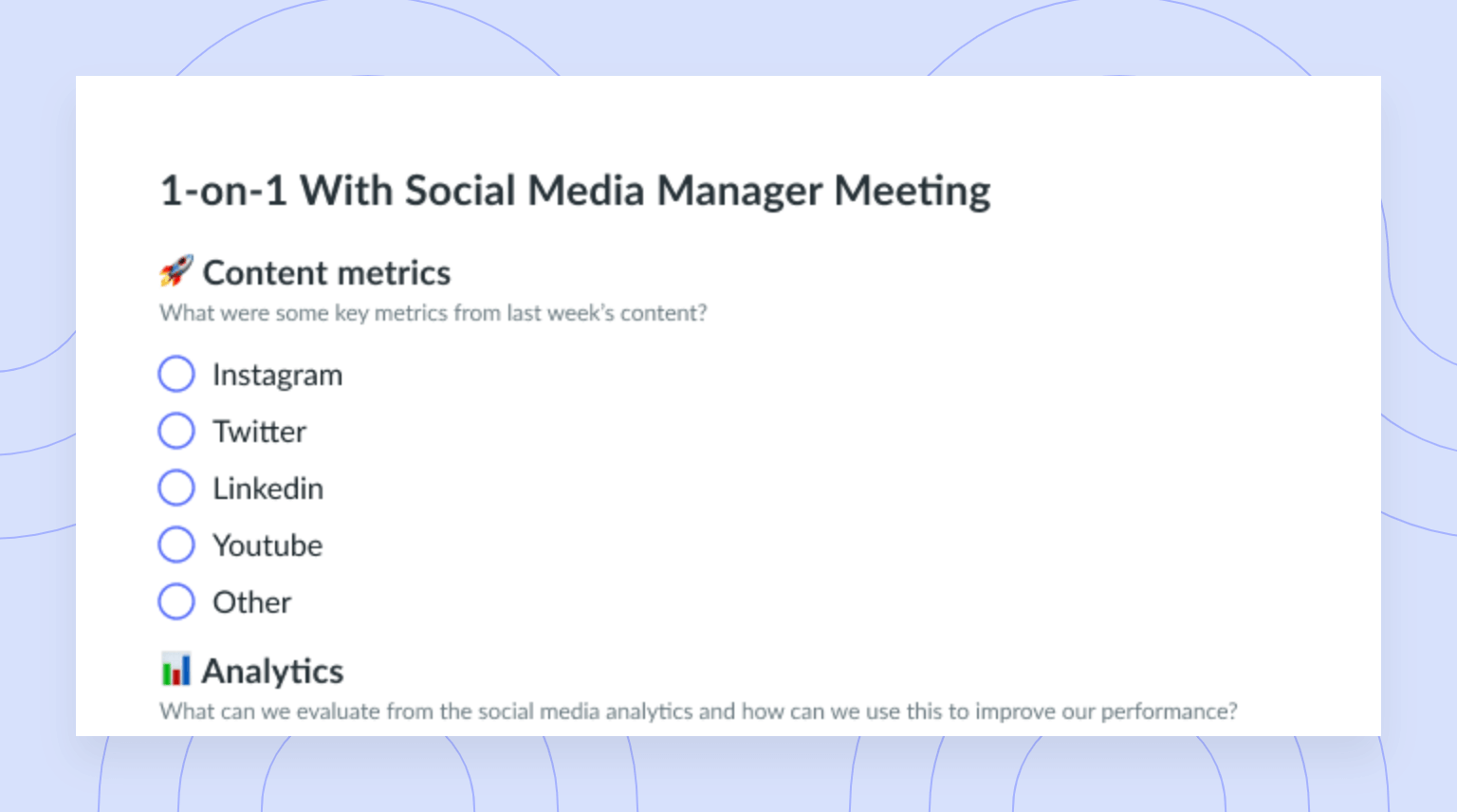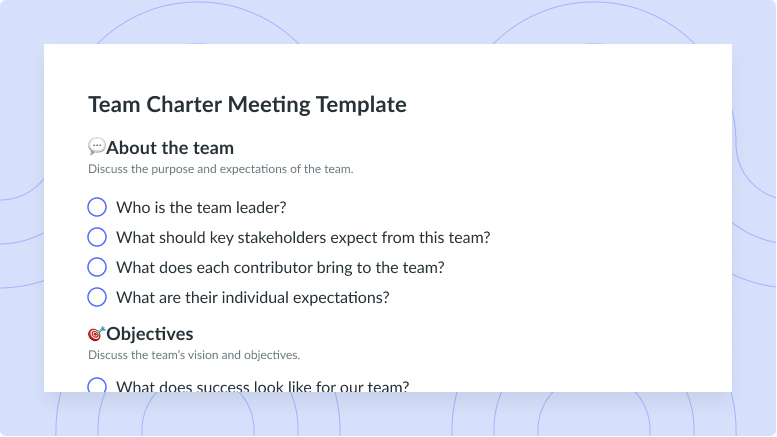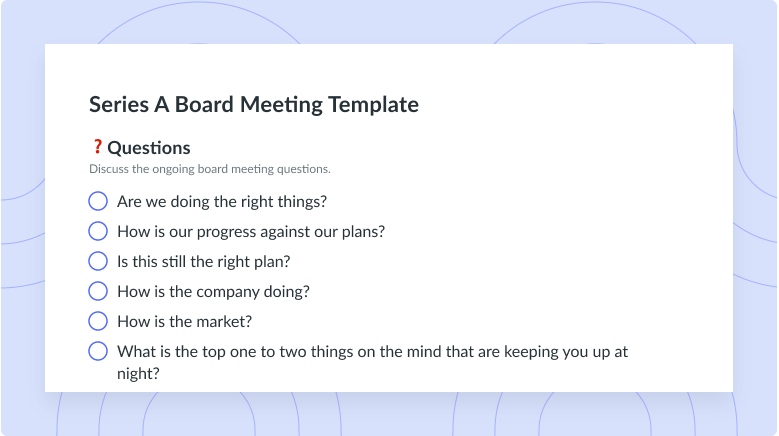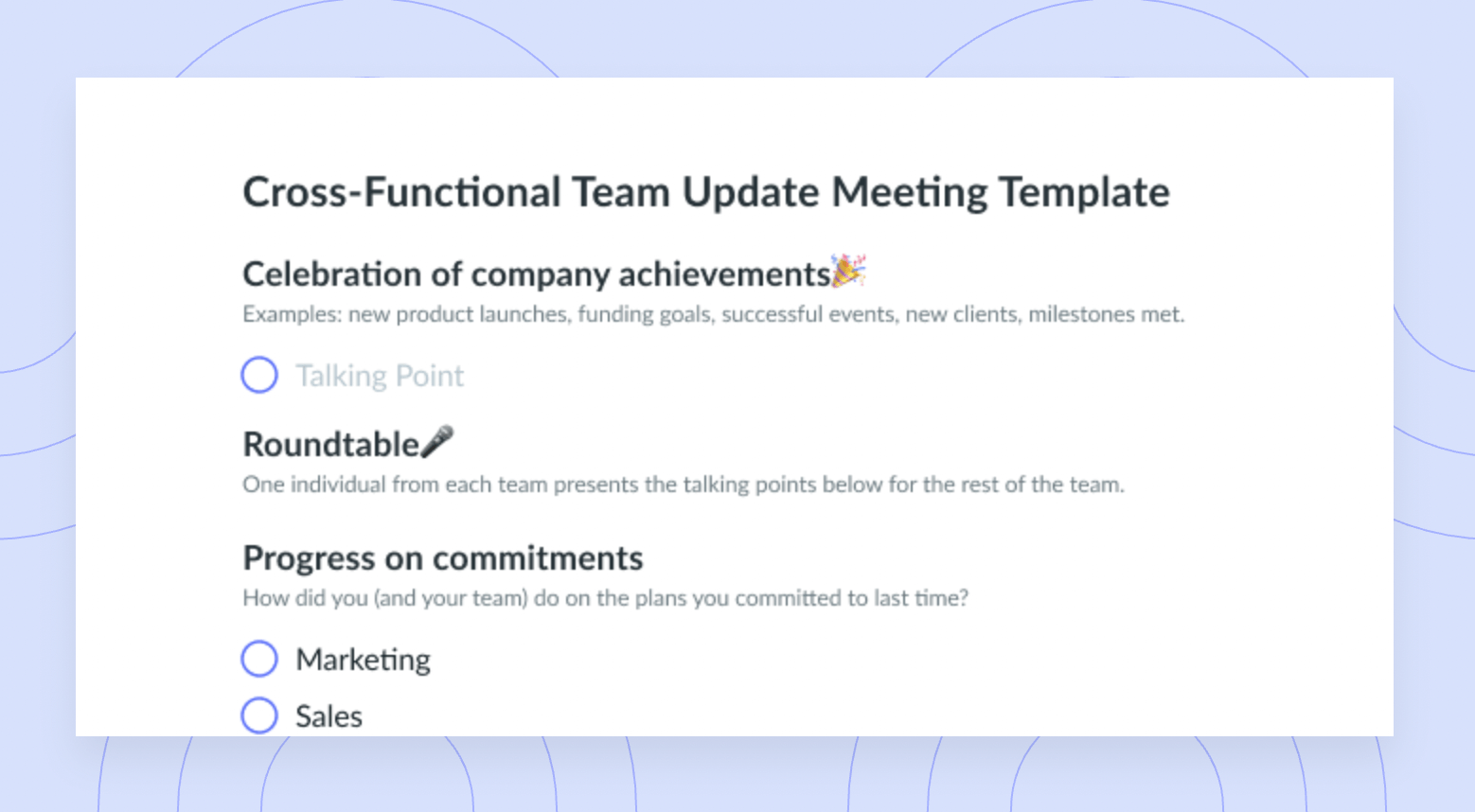RACI Meeting: Your Complete Guide to a Well-Informed Team
Use the RACI meeting method to start assigning tasks that fit your team and projects. Keep reading to learn how to conduct a RACI meeting!
Miscommunication and misunderstandings can cause a smooth-sailing project to start travelling on a bumpy road. When that happens, you might call a team meeting to clear up any confusion and iron out the latest work. But sometimes, meetings can accidentally have the exact opposite effect and create even more confusion.
If you’re running into that problem more often than not, you might want to switch to the RACI meeting system. Read on for a comprehensive overview of the RACI project management method and how it can benefit you and your team.
- What is a RACI meeting?
- The RACI components
- How to conduct a RACI meeting
- Use cases of the RACI model
What is a RACI meeting?
A RACI meeting is your typical team meeting, but with the RACI matrix as its basis. While you shouldn’t use RACI charts to run your meeting, you can use it to improve how you assign tasks. Think about it like this: Who’s responsible for what is often a question that comes up at meetings. With a RACI chart, you can clearly define each team member’s role during your meeting – and get to work more quickly afterward.

Run productive RACI meetings
Increase meeting engagement and productivity with a collaborative agenda that the whole team can contribute to. Try using a tool like Fellow!

The RACI components
RACI stands for responsible, accountable, consulted, and informed. Each term represents a well-defined role that can keep things running smoothly during any project. Below are more exact definitions of these roles so you can best pair them with your team members.
1Responsible
The responsible team member is exactly what you think – the person responsible for doing a specific task. For example, if you’d like a meal prepared, then the name of your best chef would go here. Generally speaking, most tasks only have one person responsible for them, but more is okay as long as people aren’t stepping on each other’s toes.
2Accountable
It can be easy to confuse the responsible and accountable roles. The terms have similar meanings, and the people behind them often work closely together. In a RACI roles context, the accountable person oversees the responsible party’s work and makes sure it gets done. They’re the final quality control check before the final product goes out. Returning to the chef analogy, whoever’s accountable is the final taste-tester before sending a dish out into the world.
3Consulted
People in the consulted role are one step removed from the task itself. They aren’t directly involved with its completion, but they’re available as subject matter experts for people in the responsible and accountable roles. While this role can belong to someone on the team, it can also belong to someone outside your team. In those cases, cross-functional collaboration is a huge part of the RACI method. Often, multiple people take on consulting roles to give everyone as many perspectives as possible on how to solve a problem.
4Informed
The informed role is the furthest removed from the task while still having a stake in it. It’s the position with the widest net, so to speak – it can include just about anyone within the company. Usually, informed people will be colleagues who work with your project after its completion. That could mean a marketing manager who brings already-created content out into the world. It can also include shareholders with a financial stake in your success. Keeping informed people in the loop when you reach important project milestones is important regardless of how distant they are from the work.
How to conduct a RACI meeting
When you apply your RACI model to the typical team meeting, you can reduce confusion over who does what and when. That said, it’s one thing to know what “RACI” stands for and another to know how to apply it at meetings. Keep reading for a list of steps you can take to introduce the RACI responsibility assignment matrix to your meeting room.
- Explain the RACI model to your team
- Use a RACI chart
- Apply the RACI system for project tasks, milestones, and decisions
- Line up your RACI chart with a detailed project plan
- Keep a quick reference for the RACI roles
- Assign team members to tasks that suit them
1Explain the RACI model to your team
RACI isn’t a particularly complex idea, but it’s still better not to spring it on your team. Explain it first to avoid confusion. Make sure to outline the main responsibilities of each role and how they’re involved in your project tasks. This way, everyone at the meeting starts on the same page, and there’s minimal risk of miscommunication happening down the line.
2Use a RACI chart
Make sure to mark each team member on a RACI chart as you assign their roles. It works as a quick visual aid showing who plays which roles for which project tasks. A well-written chart can help eliminate any confusion at your meetings.
A great RACI chart also helps team members keep track of each other. The person in the accountable role doesn’t have to spend time figuring out whoever’s responsible for a certain task. In turn, the responsible person can more easily find team members in consulting roles to ask for advice.
3Apply the RACI system for project tasks, milestones, and decisions
The RACI system is more suited for smaller-scale project tasks and milestones. Sure, nothing is stopping you from using it to organize large-scale projects. But the more people the system has to account for, the higher the chance for error.
Additionally, as you’re assigning RACI roles in a team meeting for projects and tasks, don’t assign them for the meeting itself. That just adds a layer of complexity that will make your meetings longer, and there’s a limit to how long meetings should last.
4Line up your RACI chart with a detailed project plan
The RACI matrix only tells your team who is responsible for what – it doesn’t leave room for more detailed task information. That’s why you should couple your RACI chart with a more in-depth project plan to fully understand everyone’s assignments. Doing so provides a clearer overview of the project during your meetings and breaks it down into chunks relevant to each team member.
5Keep a quick reference for the RACI roles
One notable drawback of the RACI system is that the roles can sometimes seem interchangeable or unclear. For example, the similar definitions between responsible and accountable can trip up the people in those roles if they’re not clearly defined. The consult and inform roles don’t quite have the same problem, but there can still be some confusion since they’re both so hands-off. Keeping clear definitions and role assignments within the RACI framework on hand at your meetings can help.
6Assign team members to tasks that suit them
One of the best ways to reach your goals is to assign your team to the right roles during your RACI meetings. Most tasks will require a unique skill set to complete, and not every team member will have the experience to excel at every task. That’s the benefit of RACI. It can help put people where they need to be while making it much easier to adjust those roles as necessary.
Use cases of the RACI model
Presumably, you now see why the RACI model is useful, but that leaves the question of when it’s the most useful. Knowing when you and your team can especially benefit from using it can help you choose when to bring it into meetings. Here are some meetings that might benefit from the RACI model.
When the decision-making process causes delays
Working with multiple people on one task can help turn something good into something great. But put too many people on a simpler assignment, and the differing opinions can slow it down to a slog. The RACI model creates clear ownership of a task with only one or two individuals having a say in how it gets done. That can make assigning meeting action items feel like a breeze.
When there’s uncertainty about task ownership
A RACI chart can help make it clear which team members are assigned which tasks. With everyone involved in a task or project obvious on the chart, you can more easily resolve meeting conflicts after – or even before – they start.
When the project workload is not distributed evenly
If one of your team members consistently does great work, it’s easy to start relying on them over others. Maybe you should reconsider that: This approach can cause one of your best to burn out and lower everyone else’s employee engagement. So instead, during your meetings, use RACI to assign people to tasks suited for them so the workload is distributed evenly. This way, your team can feel like they all contribute equally to your success.
When you need to onboard a new team member
You often can’t control when a new person needs to be brought onto the team, but you can make the onboarding process smoother. Ideally, you want your new team member to require as little catch-up as possible so their productivity can get back on track. With a RACI chart and project plan, you can provide a picture of each assignment and a list of expert consultants. Your new hire can hold their own RACI meetings with this person, who can then help them adjust to the work.
Make your team a well-oiled machine
Miscommunication happens, but it’s never pleasant – isn’t it frustrating when two people accidentally work on the same task separately? That’s time lost that you can’t get back. But with RACI meetings, you can keep those issues at a minimum. And with Fellow’s meeting tools, you can seamlessly run your next RACI meeting. You can use Fellow to collaborate with your team on building your RACI meeting agenda. In Fellow’s Streams tool, you can take notes on everyone’s RACI roles. Use Fellow and the RACI system together, and your team can always stay informed and on-task.









